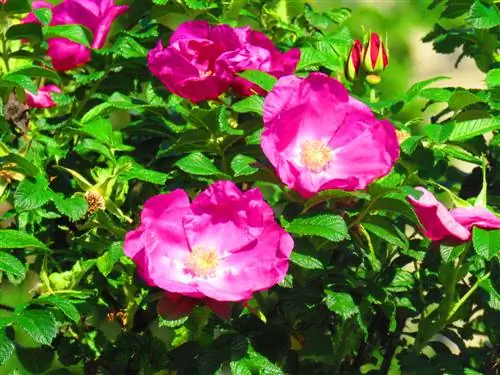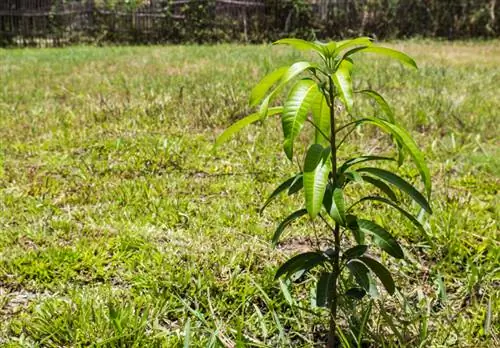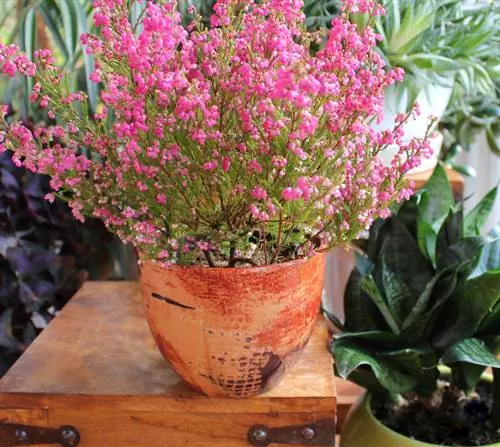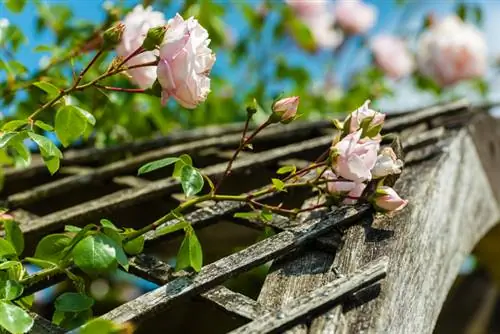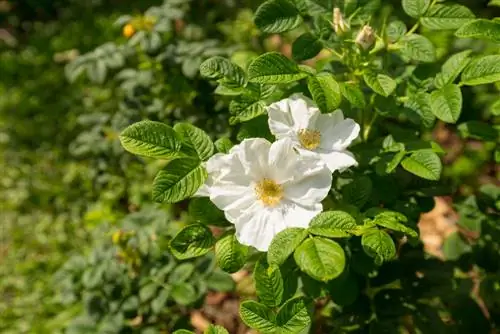- Author admin [email protected].
- Public 2023-12-16 16:46.
- Last modified 2025-01-23 11:22.
Read here in the commented profile whether the rose hips of a potato rose are edible. This is how you properly plant and care for apple roses in a pot or bed.
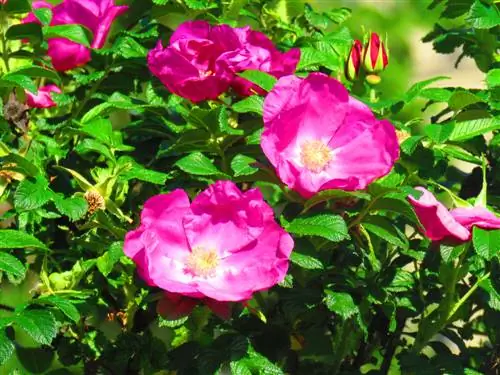
Are potato rose hips edible?
The rose hips of the potato rose (Rosa rugosa) are edible and contain valuable ingredients such as vitamin C, vitamin A, pectins and minerals. They have a sweet and sour taste and are suitable for jam or tea. However, the hairy seeds should be removed before consumption.
Profile
- Scientific name: Rosa rugosa
- Synonym: apple rose
- Growth: shrub
- Origin: East Asia
- Leaf: pinnately pinnate
- Flower: simple, fragrant
- Flowering period: June to October
- Fruit: Rose Hip
- Fruit properties: edible
- Roots: deep roots/runners
- Winter hardiness: hardy
- Use: hedge, ornamental shrub, natural garden
Fruit properties
In September and October, the fragrant flowers of a potato rose turn into cluster nuts, also known as rose hips. The following overview summarizes important fruit properties:
- Consumption quality: edible (pulp) and inedible (seeds)
- Color: green (unripe), red (ripe)
- Shape: spherical to apple-shaped
- Size: 2cm to 4cm
- Taste: sour to sweet and sour (the riper, the sweeter)
- Ingredients: Vitamin C, Vitamin A, pectins, carotenoids, tannins, minerals, trace elements
- Healing effects: immune-boosting, appetite-stimulating, diuretic, laxative, detoxifying, anti-inflammatory
You can eat rose hips raw as long as you first remove the hairy seeds from the pulp. The juicy pulp is often prepared as a refreshing jam. You can brew dried rosehip peels and seeds to make an aromatic tea with natural healing properties.
Leaf
The potato rose is cultivated in hobby gardens primarily because of its unbeatable leaf he alth. While fungal diseases are common in cultivated roses, the wild rose proves to be resistant to sooty mold, powdery mildew, rose rust and other rose diseases. This is what the leaf of an apple rose looks like:
- Form: imparipinnate, five to ninefold
- Size: 4 cm to 15 cm long
- Color: dark green on top, gray-green on the bottom
- Leaf edge: double sawn
- Leaf surface: wrinkled, silky hairy
- Autumn color: yellowish to ocher yellow
With their wrinkled surface, the leaves are reminiscent of the foliage of a potato plant, which is what the name potato rose refers to. The wild rose owes its second name, apple rose, to the red, spherical rose hips.
Growth
The potato rose thrives as a summer green shrub with the special properties of a wild rose. The following characteristics characterize the growth:
- Growth habit: tightly upright, later arching overhanging
- Growth height: 120 cm to 150 cm, under ideal conditions up to 200 cm
- Growth width: 100 cm to 150 cm
- Annual growth: 20 cm to 40 cm
- Special feature: Spread via underground runners; forms an impenetrable thicket without pruning
The growth of an apple rose is characterized by numerous, short spines on the shoots, which, unlike thorns, can be easily removed.
Usage
With its specific growth characteristics, the potato rose is recommended for uses that other types of roses cannot offer in this combination. The following table provides an overview:
| Hedge | ornamental shrub | Natural Garden |
|---|---|---|
| Enclosure | Solitaire in the front garden | Bee Pasture |
| Privacy protection | potted plant balcony | Bird food plant |
| Windbreak | Area greening | Medicinal plant |
| Pioneer trees | potted garden | Crops |
With its deep main roots and underground runners, the potato rose anchors itself firmly in any soil. This makes the wild rose the perfect hedge plant with wind and privacy protection functions. As a s alt-tolerant pioneer tree, the shrub prevents soil erosion on sandy embankments along the North Sea coast. In a pot or as a solitary plant in the bed, the potato rose is an easy-care feast for the eyes. The wild beauty of roses enriches the natural garden as a pasture swarmed by bees. Nature-oriented hobby gardeners leave the rose hips hanging for hungry garden birds and snack on homemade apple roses from the kitchen:
Video: Make your own apple roses - recipe for those with a sweet tooth
Planting potato rose
If planted correctly, a potato rose can grow very old without losing its ability to bloom. Don't miss the following information about choosing a location, planting time and planting:
Location
Of all rose types, the potato rose probably has the best s alt and wind resistance. The wild rose cannot be harmed by bitter cold or sweltering heat. Under these conditions, choosing a location is easy:
- Full sun to partial shade
- In sandy to nutrient-rich garden soil with acidic to slightly alkaline pH value
- Extra tip: Potato rose doesn't like full shade, waterlogged soil (€20.00 on Amazon) or extremely hot locations
The wild rose accepts heavy clay soil as a location after improving it with ripe compost and sand.
Planting time
The potato rose is ideally planted in autumn or spring. Because the wild rose is so undemanding, you can buy and plant inexpensive, bare-root young plants from specialist retailers all year round.
Planting in the bed
Before planting, place the roots in a bucket of water. Meanwhile, dig spacious planting pits in the bed. In a solitary position, place one potato rose per square meter. So that the wild roses turn into an opaque windbreak hedge, the correct planting distance is 3 bushes per meter, or 3 to 5 young trees per square meter. In small gardens, planting with a root barrier is advisable so that potato roses do not spread and multiply uncontrollably via their runners.
Planting in a bucket
The perfect pot for Rosa rugosa offers enough space for the deep main roots and runners. It is important to have several holes in the floor for water drainage. As a substrate, we recommend a mixture of peat-free rose soil or pot plant soil, enriched with coconut humus as a peat substitute and expanded clay for airy, loose permeability. This is how you plant a potato rose in a pot correctly:
- Line the bottom of the bucket with pottery shards or expanded clay balls as drainage.
- Fill in the substrate up to half the height of the pot.
- Plant the water-soaked root ball while maintaining the previous planting depth with a 5 cm high watering edge.
- Press the rose soil with both hands and water thoroughly.
- Extra tip: pile apple roses up to half the height to protect against drought stress.
Pruning is not mandatory for wild roses. To ensure that a potato rose has dense and bushy branches from the base, you can cut the shoots back by a third or half.
Excursus
Potato rose dog rose difference
The potato rose comes from East Asia, has short spines and grows to a height of 150 centimeters. In contrast, the dog rose (Rosa canina) is a native wild rose with long, hack-shaped spines and a growth height of up to 500 centimeters. The rose hips of a potato rose are fleshier and larger than the fruits of a dog rose.
Care for potato rose
The potato rose is undemanding. Well-rooted wild roses make do with natural rainfall. Cultivated in a pot, an apple rose depends on regular watering in dry conditions. Read informative care tips for a potato rose in top shape in the following sections:
Fertilize
- Fertilize Rosa rugosa organically in the bed once a year.
- In March, distribute 3 to 5 liters of compost and 100 grams of horn shavings per square meter, rake in and water.
- Give apple roses in pots a liquid fertilizer for flowering plants every month from April to September.
Cutting
Wild roses are rarely pruned. In contrast to grafted rose varieties, a ground shoot remains blooming and vital for up to six years. Pruning care is primarily aimed at regulating the spread and preventing aging. How to cut a potato rose correctly:
- The best time is mid/late February in mild winter weather
- Put on sturdy gloves and safety glasses
- First thin out the bush thoroughly
- Cut off a third of the old ground shoots (dark wood) at the base
- Cut back excessively long and awkwardly positioned shoots
- Place the rose scissors a few millimeters above the buds
- Important: do not cut annual, unbranched ground shoots
To keep a potato rose small, prune it every year. You should thin out a privacy hedge every two to three years so that the bushes do not become bare from below. Breathe new life into old apple roses with a rejuvenation cut to three to five buds. Because the legislature has a say in all radical tree pruning, the time window is only open from the beginning of October to the end of February.
Propagate
The easiest way to propagate a potato rose is to use the runners. In spring, use the freshly sharpened spade to cut off a piece of the runner, including the roots and sprouting young plants. At the new location, put the floral offspring back into the ground and water. More sophisticated methods of propagation include sowing seeds and growing from cuttings.
Popular varieties
Since the potato rose migrated to Europe from East Asia in the 19th century, numerous decorative varieties have emerged:
- Alba: Premium variety with pure white cup flowers for wild rose hedges and Friesenwall, growth height 120-150 cm.
- Dagmar Hastrup: easy-care potato rose with 8 cm large, pastel pink flowers, height 100 cm.
- Schneekoppe: frequent flowering variety with semi-double, white flowers and red rose hips, height 80-100 cm.
- Yellow Dagmar Hastrup: beautiful ground cover rose with yellow, semi-double flowers, height 70-90 cm.
FAQ
Is there a simple recipe for rosehip jam?
How to conjure up a refreshing rosehip jam in no time: First remove the stem ends and black flower bases. Steam the cleaned rose hips in a pot with water. Pass the soft fruits through a sieve to separate the pulp and seeds. Put 500 grams of pulp in a saucepan with 125 milliliters of water and the juice of a quarter of a lemon. Bring the mixture to the boil and add 250 grams of preserving sugar (2:1), stirring constantly. After another five minutes of gentle simmering, the jam is ready and can be poured into clean screw-top jars.
What is the difference between potato rose and dog rose?
The potato rose (Rosa rugosa) comes from East Asia, whereas the dog rose (Rosa canina) is a native wild rose. Their different origins are reflected in their growth. A potato rose grows 1.50 meters high and wide. A dog rose demonstrates its home advantage by growing majestically up to 5 meters high. It achieves this with long, hook-shaped spines that are suitable as climbing organs. With its short thorns, an apple rose is prevented from daring climbs to lofty heights. The rose hips of potato roses are larger, thicker and juicier than the fruits of dog roses.
How to overwinter the potato rose?
The potato rose is frost hardy. No special precautions need to be taken against frost and snow outdoors. However, when cultivated in a pot, the wild rose is vulnerable to frost damage. To prevent the root ball from freezing, place the pot on a wooden base. Cover the container with fleece or bubble wrap and cover the substrate with bark mulch.

